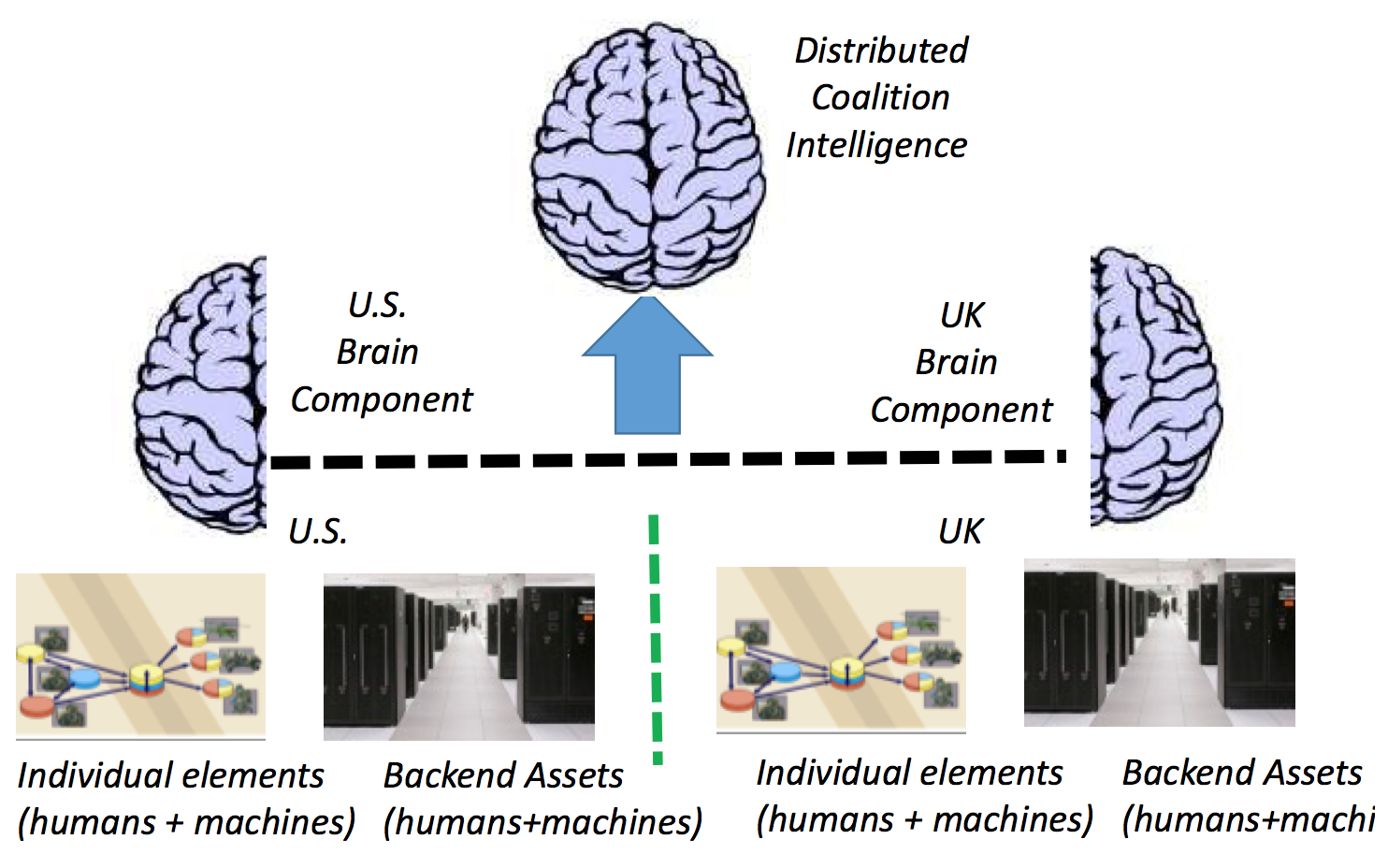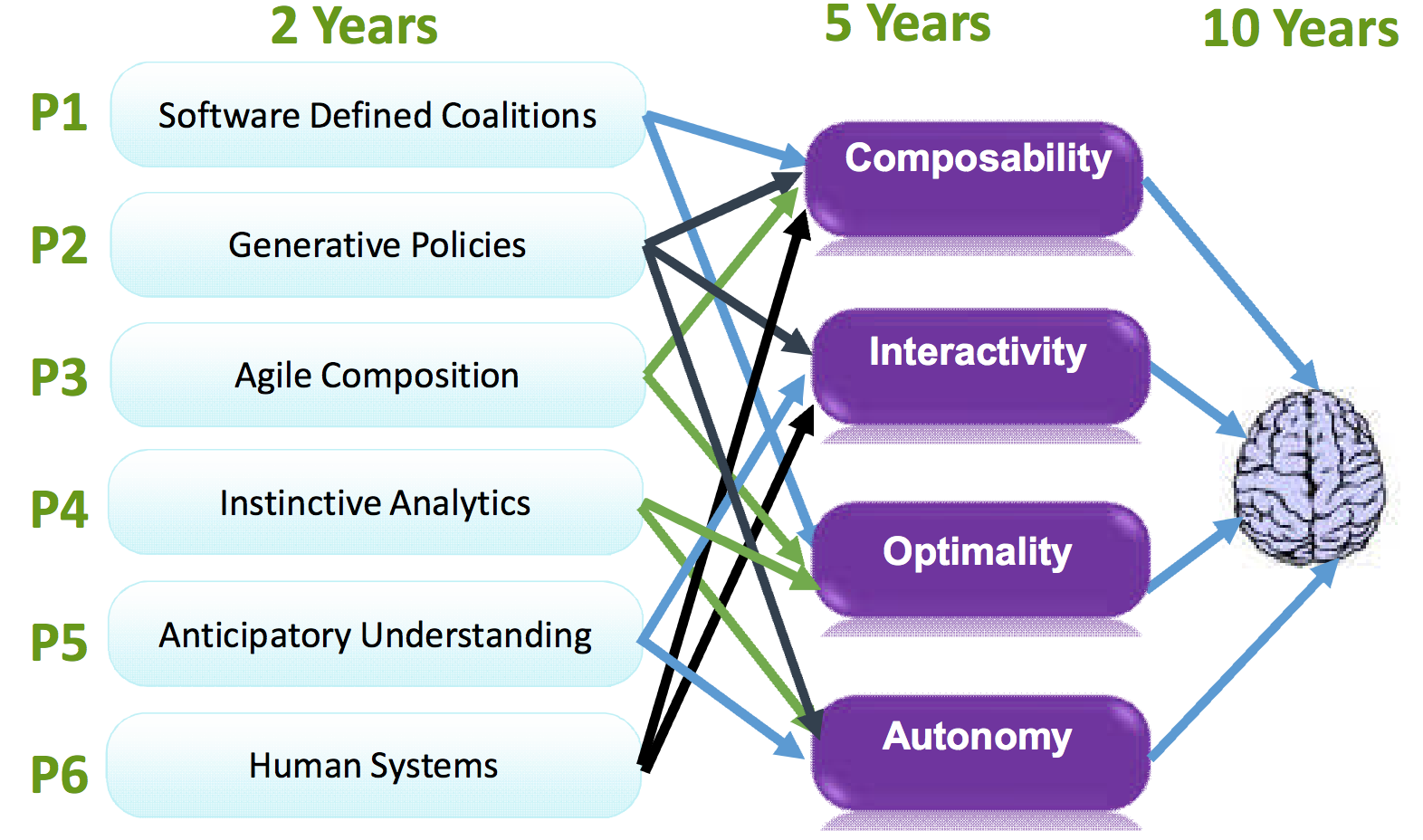Project Aims
Research Vision
With the explosion in low cost phones, wearables and the Internet of Things, most coalition operations will take place
in an environment with a diverse set of small elements capable of computation, storage and communication. We propose leveraging
the various devices available across the coalition members to create a system with distributed collaborative
and cooperative capabilities. This interconnected system will provide an infrastructure for performing analytics
required for coalition operations. It will leverage all the services offered by a wired backend infrastructure
(e.g. a backend cloud system, data center or available cellular network infrastructure) but it will not be critically
dependent on a continuous connectivity to the backend.
We envision a future where the interconnected system operates seamlessly across networks and systems belonging to
different organizations (i.e. coalition members or sub-groups within a single coalition member). This system is frequently
charged with performing tasks that require creating dynamic groups on a short notice. Such dynamic groups may be short-lived
(days or hours), but could also last for a longer period (months). Differences in the pedigree of disparate systems belonging
to different organizations necessitate the development of approaches that work with partial visibility, partial trust, and
cultural differences, while simultaneously dealing with the challenges of a dynamically changing situation in which power,
computation and connectivity may be severely constrained.
We want the ability to create an intelligent interconnected system, i.e. a system that can analyze the situation
on the ground in real-time, anticipate the situation likely to happen in the future, and determine whether the situation
requires human involvement. If the situation does not require human involvement, the system would undertake the most appropriate
automatic action to the situation. When the situation needs human involvement, the system will recommend alternative courses
of actions, along with their pros and cons. We refer to this capability that coordinates different elements, with opportunistic
assistance from a fixed infrastructure with interrupted connectivity, as the distributed coalition intelligence.
2,5 and 10 Year Goals
The goal of our basic research is to discover and formulate the scientific principles that enable the physical
realization of distributed coalition intelligence at the conclusion of our 10-year research agenda. This physical
realization will require the transition of our basic research into the appropriate systems and solution development.
We use the metaphor of a distributed brain to describe the end-vision. Just as the human brain is made of two parts,
a left hemisphere and a right hemisphere, the distributed coalition intelligence will be an aggregation of several
smaller sub-brains, each sub-brain belonging to a coalition member. All of the sub-brains work in a coordinated manner
to perform analytics, and leverage the assets and knowledge available across the entire system. Just like the left hemisphere
and right hemisphere of the human brain react differently to different stimuli, we expect different sub-brains to react differently
in any situation, but the overall distributed system coordinates the different reactions in a seamless manner
as needed. A pictorial representation of the concept is shown in Figure RP-1.

To attain the 10-year goal outlined above, we need to understand the fundamental principles underlying some of
the key properties of the distributed coalition intelligence when applied to analytics. Our 5-year goal is to understand
those principles underlying those properties.
In order to achieve our strategic vision, we must get an insight into the following properties by the end of 5-years.
- Composability:How do we compose smaller elements into a larger aggregate that works like a seamless whole? What are the principles that link the attributes of a component to the larger whole, and how can we compose components belonging to different organizations with partial visibility and control in an environment with limited resources? Individual elements (humans + machines) U.S. UK Backend Assets (humans+machines) Individual elements (humans + machines) Backend Assets (humans+machines) U.S. Brain Component UK Brain Component Distributed Coalition Intelligence
- Interactivity:How do different computing elements and people interact with each other, both with other members of the groups and to external stimulus from the environment? How should we model and understand the interactions between different elements and information sources? How do different sub-brains work together as a larger aggregate brain under?
- Optimality:How can elements work together to obtain the optimal results in an environment with constrained resources? How can analytics be performed so that optimal performance is obtained automatically, instead of requiring complex manual optimization?
- Autonomy:How can elements work together in a proactive manner understanding future situations sufficiently well to operate with a degree of autonomous behavior? How can a system determine that autonomous operation is inappropriate and human intervention is needed? How can different elements simplify the cognitive burden involved to best assist humans in the loop when intervention is needed?
Understanding the principles behind these four attributes will allow us to attain significant capabilities
for military defense as articulated in the UK MoD Technology Roadmap and in the U.S. third offset strategy.

Our six projects are defined so that the insights we obtain from them can be combined to help us understand the underpinnings of the four attributes.
Our current view on how the different projects can be linked together to obtain the understanding of the four properties
at the 5-year point is shown in Figure RP-2. Specifically, we plan on combining the results from projects P1, P2, P3 and P6
to understand the principles underlying composability, the results from projects P2, P6 and P5 to understand the principles
that explain interactions among groups, the results from projects P1, P3 and P4 to understand how to self-optimize a system
under limited resources, and the results from projects P2, P4 and P5 to understand the principles of autonomy. The results from
the 5 years will be combined to get insights into principles governing the distributed coalition intelligence, which will enable
us to physically realize such a system in 10 years by combining these scientific insights with appropriate systems building efforts.
Figure RP-2 P1 Software Defined Coalitions P2 Generative Policies P3 Agile Composition Human Systems P4 Instinctive Analytics
P5 Anticipatory Understanding P6 2 Years 5 Years 10 Years Composability Intera
Kin's team at Imperial will be mainly focused on P1 and P3.
Project 1 - Software Defined Coalitions
To attain the vision of a distributed brain, we need to understand how different elements in a coalition can be
composed together to form an efficient, unified, agile infrastructure, despite substantial resource constraints,
high levels of dynamicity and local policies restricting coalition participation. The focus of P1 is to discover
the fundamental principles and techniques by which we can obtain such composition. Extending Software Defined Networking
(SDN) concept of separating the control and data plane to all coalition resources, including communication, storage
and computation, to enable a new level of agility and dynamism, P1 has introduced the new architecture called
Software Defined Coalitions (SDC), to realize many benefits including programmable coalition management,
easy reconfiguration, on-demand resource allocation, and rapid response to network anomaly/failures.
Realizing an SDC infrastructure can lead to major advancements to support the overall DAIS-ITA project goal,
for diverse settings from combat operations to intelligent operations to humanity operations.
Project 3 - Agile Composition for Coalition Environments
In tactical coalition environments, operators from different coalition members require analytics that compete for limited resources. The resources themselves may also belong to different coalition members. For example, an operator could ask whether any seismic sensor has detected vibration within a spatial/temporal window which could be related to an explosion, or subscribe to notifications on such events. To serve the request, the coalition network needs to run distributed analytics, which may involve multiple machine learning models and multiple datasets.
In Project 3 of BPP18, we tackle the problems of how to efficiently and flexibly control and manage distributed resources (computation, network, and storage) to support dynamic composition and execution of distributed analytics services in coalition environments. Specifically, we investigate the problem in the following two tasks:
- Task 1explores how to represent, disseminate, and allocate the coalition resources for analytics services via distributed control mechanism, and investigates fundamental resource-performance tradeoffs for achieving the optimal distributed-analytics operations of coalition infrastructure within operational constraints and policy.
- Task 2:investigates where to place the analytics code and data in the distributed system via joint decision making of multiple elements in service placement/scheduling under dynamic and unpredictable changes of demands and resource availability, and further addresses the issue of validating the Quality of Analytics (QoA) of given service placement/scheduling across coalition boundaries.